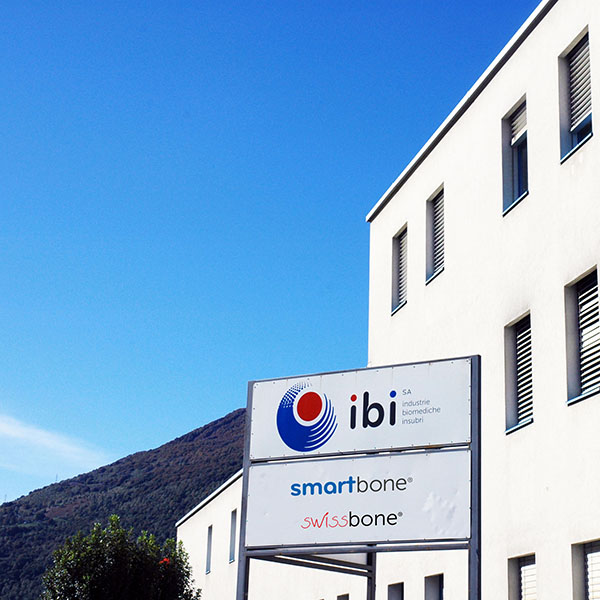CLOSE

SmartBone®, SmartBone® ORTHO, SmartBone® On Demand™ and SwissBone® are produced by combining natural mineral bone structures with bioresorbable polymers and collagen fragments. This new concept of biomaterial assembly allows the patient’s cells to grow quickly and efficiently into the bone substitute while the biopolymers degrade, providing perfect integration and osteogenesis. Moreover, thanks to this technology our graft mimics the human bone, it is mechanically strong and resistant to shaping, screws and surgical fixation maneuvers.
SmartBone®, SmartBone® ORTHO, SmartBone® On Demand™ and SwissBone® are exactly the same products with just different brand names or different indications of use.
Allow to have:
Help to:

The microstructure of SmartBone®, SmartBone® ORTHO, SmartBone® On Demand™ and SwissBone®’s composite matrix strongly resembles the human bone in terms of open, interconnected and mid-sized porosity. Indeed, it mimics the characteristics of a healthy human bone: high biocompatibility, adequate open porosity, high mechanical performance, hydrophilicity.
SmartBone®, SmartBone® ORTHO, SmartBone® On Demand™ and SwissBone® were designed to reduce the inner variability that many other bone substitutes have, due to their natural origin. IBI offers homogeneous bone substitutes with regular microstructure, porosity, density and mechanical properties.
Thanks to its microcomposition, SmartBone®, SmartBone® ORTHO, SmartBone® On Demand™ and SwissBone® quickly reach an av. 38%w/w blood swelling ratio, thereby sparking the chemical signaling cascade that finally induces a robust osteointegration.
SmartBone®, SmartBone® ORTHO, SmartBone® On Demand™ and SwissBone®’s microstructure and composition favor cell colonization.
The electronic microscopy analyses of in vitro cell colonization tests evidenced the presence of wide and well-structured cell formations inside SmartBone®, SmartBone® ORTHO, SmartBone® On Demand™ and SwissBone®, proving confirmation to the biochemical data collected during ISO standard in vitro tests. Biological and histological investigations showed how our bone substitutes are very supportive substrates for cell adhesion and growth; Human adipose-tissue derived Mesenchymal Stem Cells showed in vitro capability to properly colonize the scaffold and, once induced, to differentiate.
Studies were performed to assess osteointegration on a 4-month observation timeframe. Histological analysis proved confirmation of SmartBone®, SmartBone® ORTHO, SmartBone® On Demand™ and SwissBone® integration, with natural bone formation, including cells and vessels colonizing pores within it over time.
Clinical investigations confirmed SmartBone®, SmartBone® ORTHO, SmartBone® On Demand™ and SwissBone® mechanism of action: they very easily soak up large amounts of blood, thus starting micro coagulation to occur inside the graft itself and hence strongly enhancing graft integration (as far as the local micro coagulation sparkles a chemical cascade that is essential for patient native cells ingrowth into the graft); the first weeks are then needed for cellular colonization of the graft, which is also enhanced by the presence of gelatine (offering RGD-end as site-specific terminals for adhesion via linking with integrins from cells) that offers a viable environment for cells to spread onto; meanwhile, this time lag is also necessary for the degradation of the thin polymeric film, which progressively fades away leaving mineral structure for cells to consolidate and promoting the formation of new living bone (also by means of formation of new vessel); following months are needed for the integration of the graft with the native patient bone, due also to vascularization and new bone formation inside the graft via complete remodeling.
A Block (10x10x10 mm) can be harshly shaped, then drilled with two holes at a very small distance. As a result, there is no powder formation and the block doesn’t break into pieces!
During a bone reconstructive surgery, a block can be easily shaped and directly drilled in place. The absence of powder formation helps allowing to perform the drilling in situ! and the screws stay firmly in place. Moreover, hydrophilicity is very high and this allows blood to coagulated into the graft and hence spark the remodeling process.

IBI SA
Industrie Biomediche Insubri SA
via Cantonale 67, CH-6805 Mezzovico-Vira, Switzerland
t. +41 91 93.06.640
f. +41 91 220.70.00